Understanding concepts and remembering facts can often be a daunting task for students. One of the effective methods to simplify this process is through art mind mapping. It not only helps in better comprehension but also instills a sense of creativity and enjoyment in learning. In the following article, we explore 20 art mind map examples specifically designed for students, offering a diverse range of styles and subjects to inspire and assist in their academic journey. So, whether you're a student seeking new study strategies, or an educator looking for innovative teaching materials, these examples will provide valuable insights into the boundless realm of art mind mapping.
What is an art mind map?
An art mind map is a kind of mind map that presents a series of art-related details in a mind map, with which clear connections between various topics can be seen. An art mind map is very useful, especially for artists, designers, and students, when they need to create a work or get a glimpse of art history.
20+ art mind map examples for students
Mind map of Leonardo da Vinci
Leonardo da Vinci was an Italian artist who was also a polymath of the High Renaissance. He was born on April 15, 1452, in Vinci, Italy. He made great achievements in painting, leaving hundreds of works such as Mona Lisa, The Last Supper, and Annunciation. While he was most famous as a painter, he also left legacies in other fields like anatomy, botany, and physics. The example below displays Leonardo da Vinci's life and his influence and should make you get to know more about him.

Mind map of Michelangelo
Born on March 6, 1475, Michelangelo was an Italian artist famous as a painter, sculptor, architect, and poet in the Renaissance. He rocketed to fame at an early age with two of his best-known works, the Pietà and David, and was one of the three giants of the Florentine High Renaissance. Below is an example showing a detailed introduction to him.
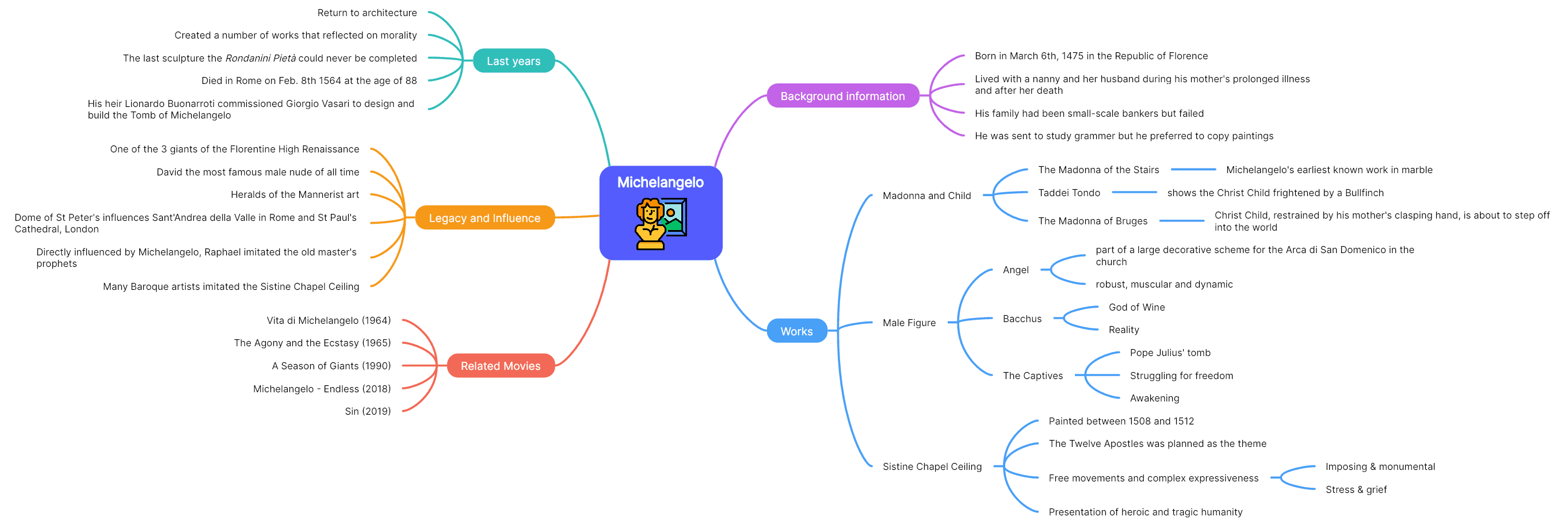
Mind map of Pablo Picasso
Pablo Picasso was one of the greatest artists of the 20th century and created Cubism with Georges Braque. He was born on October 25, 1881 in Spain. In his lifetime, Picasso dedicated himself to his art career and contributed a lot to modern art in the 20th century. The mind map below should give a brief introduction to Pablo Picasso to you.
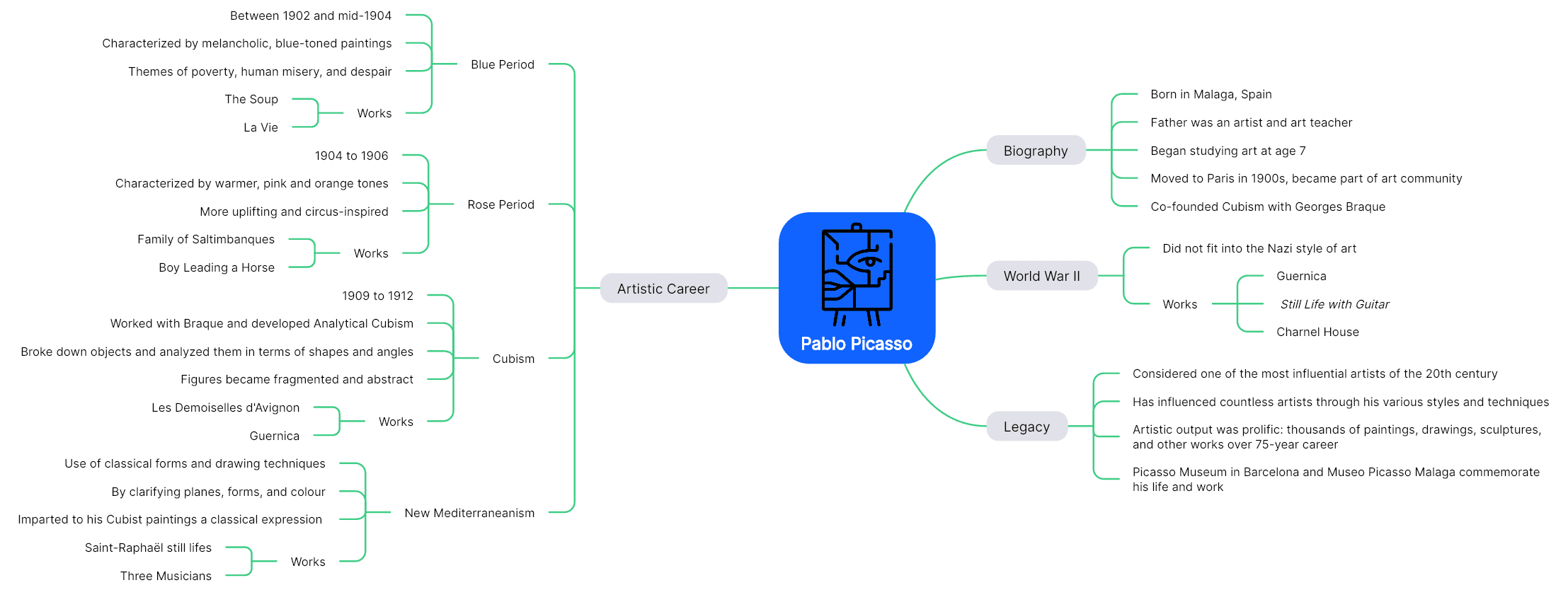
Mind map of Vincent van Gogh
Vincent van Gogh was a Dutch post-impressionist painter who is widely regarded as one of the most influential artists in history. Born on March 30, 1853, in the Netherlands, van Gogh initially pursued a career in various professions, including art dealing and teaching. Some of his most famous masterpieces include Starry Night, Sunflowers, and The Bedroom. Below is a mind map helping you get to know more about him.

Mind map of Renaissance
The Renaissance was a period in European history that spanned roughly from the 14th to 17th century, marking a shift in cultural, artistic, political, and scientific thinking. The term "renaissance" is a French word meaning "rebirth," signifying a revival of the culture from ancient Greece and Rome. Below is a mind map giving a brief introduction to the Renaissance.
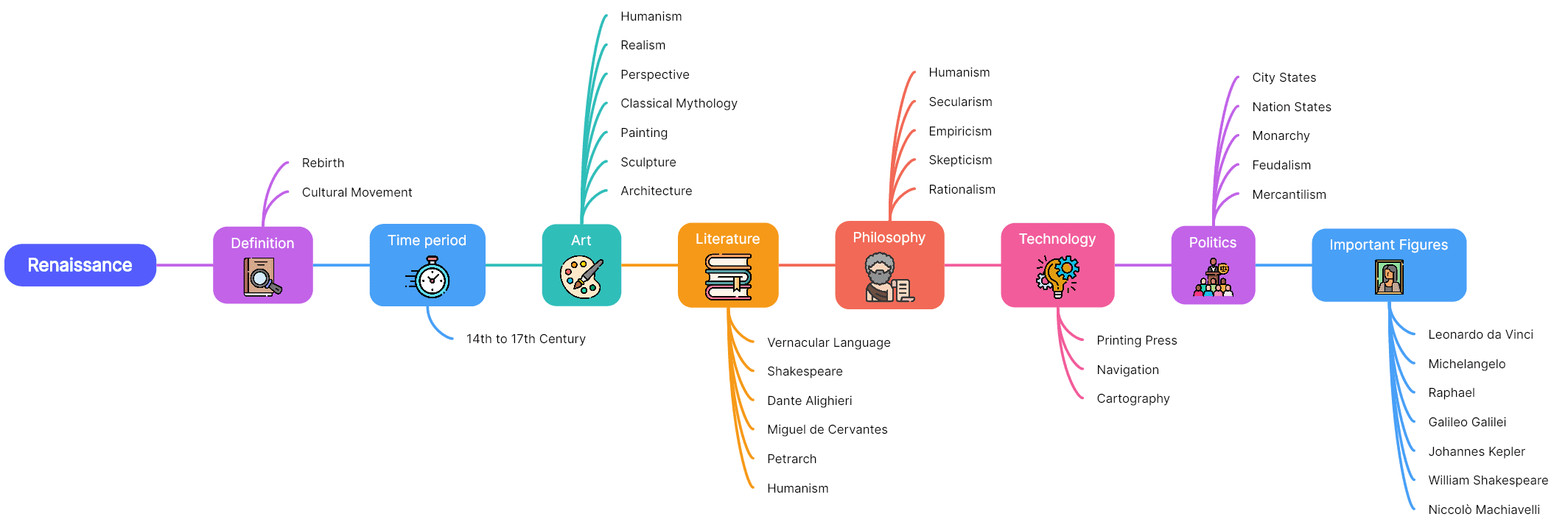
Mind map of Baroque
Born in the late 16th century in Italy, Baroque is a style of art, architecture, and music with a strong emphasis on dramatic and exaggerated elements. The works of Baroque stand out with vibrant colors, complex compositions, and extravagant details. It represents a departure from the simplicity and restraint of the Renaissance, whose influence can still be seen in modern art. You can get to know Baroque more in the mind map below.

Mind map of Rococo
Beginning in France in the 1730s, Rococo is a dramatic and ornamental style of art, architecture, and decoration that features asymmetry, scrolling curves, gilding, and sculpted molding. Below is a mind map displaying Rococo which should give you a deeper insight into it.

Mind map of Romanticism
Also known as the Romantic movement, Romanticism was an artistic and intellectual movement originating in Europe at the end of the 18th century. It reached its peak from 1800 to 1850, emphasizing emotion and individualism, and made a strong difference in arts, music, and literature. It also became the prevailing ideology of the Age of Enlightenment. Read the mind map below to know more about Romanticism.
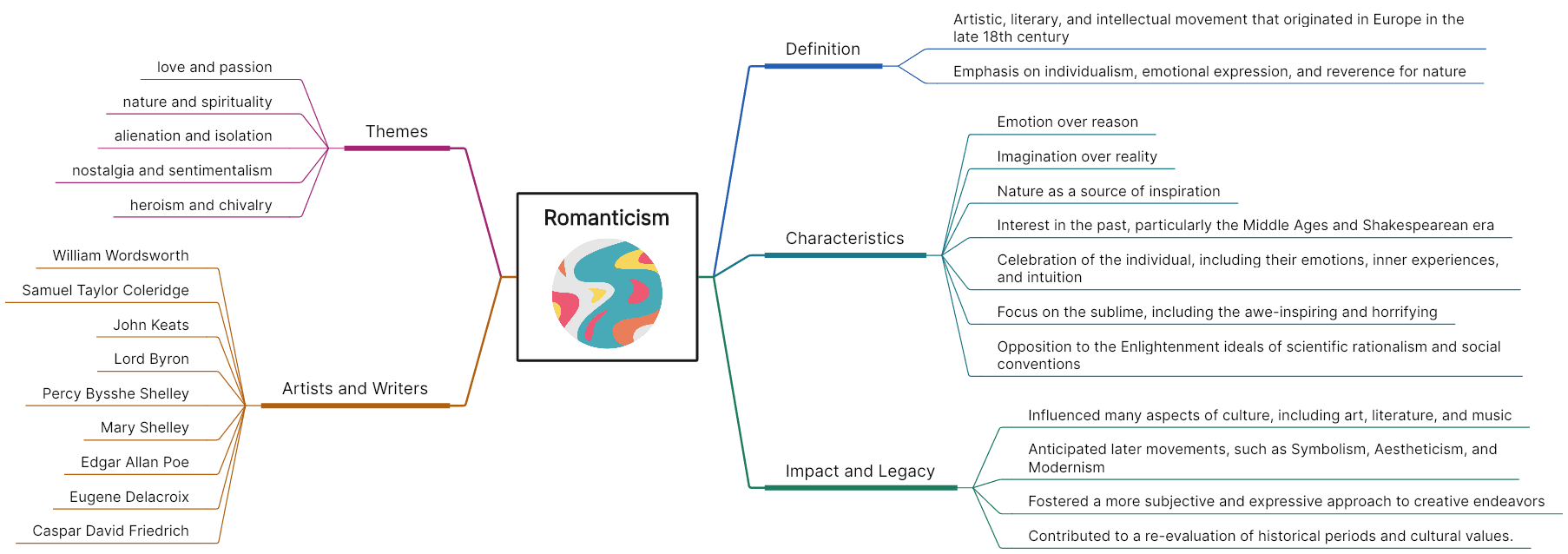
Mind map of Claude Monet
Claude Monet was a French painter of the 19th and early 20th centuries who founded and led the Impressionist style. Monet's works featured the effects of light and atmosphere and focused on the transient nature of landscapes, which made him a pioneer and leading figure in the Impressionist movement. The following example displays Claude Monet's life and his works.

Mind map of Impressionism
Characterized by its focus on capturing the impression or essence of a subject rather than its meticulous details, Impressionism was an art movement that emerged in the late 19th century in France. Pioneers of Impressionism included Claude Monet, Pierre-Auguste Renoir, Edgar Degas, and Camille Pissarro. Their works are outstanding and recognizable for their loose brushwork, visible brushstrokes, and emphasis on fleeting moments and scenes in every life. Read the mind map below to learn more about Impressionism.
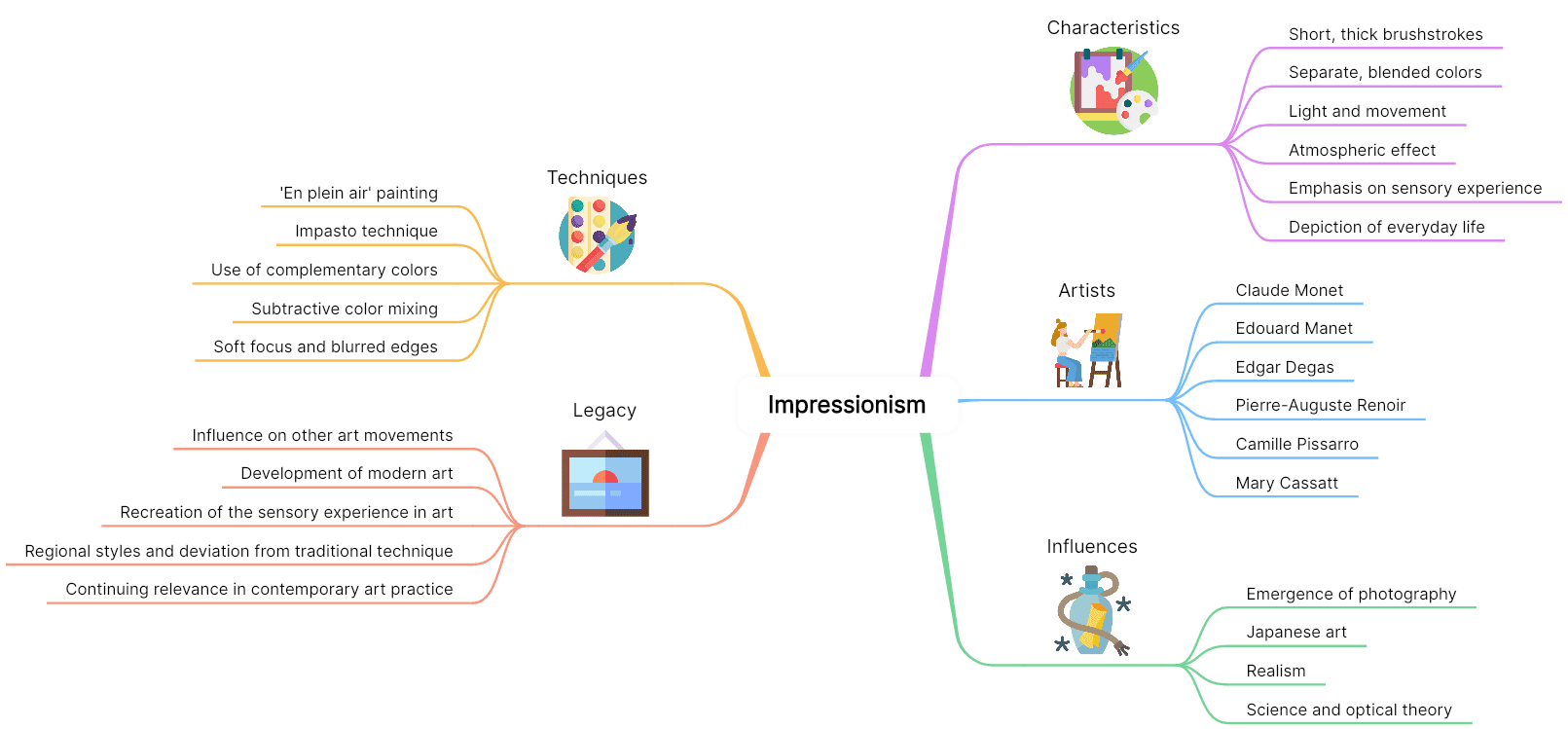
Mind map of Cubism
Cubism is a revolutionary modern art movement that emerged in the early 20th century, specifically between 1907 and 1914. It was pioneered by Pablo Picasso and George Braque, among others, and is considered a significant departure from traditional artistic approaches. The example below demonstrates Cubism and should give you a glimpse of it.

Mind map of Surrealism
Emerging in the early 20th century between World War Ⅰ and World War Ⅱ, Surrealism was an artistic and literary movement mainly in Europe. It is aimed at tapping into the subconscious mind and exploring the world of dreams and the irrational. The main figures of surrealism included Salvador Dalí, René Magritte, Max Ernst, and Joan Miró. Their works are characterized by dreamlike elements, automatic drawings, and juxtaposition of unrelated objects. Surrealism made a significant difference to the art world and beyond, influencing movements like abstract expressionism and pop art. Read the mind map below to learn more about it.
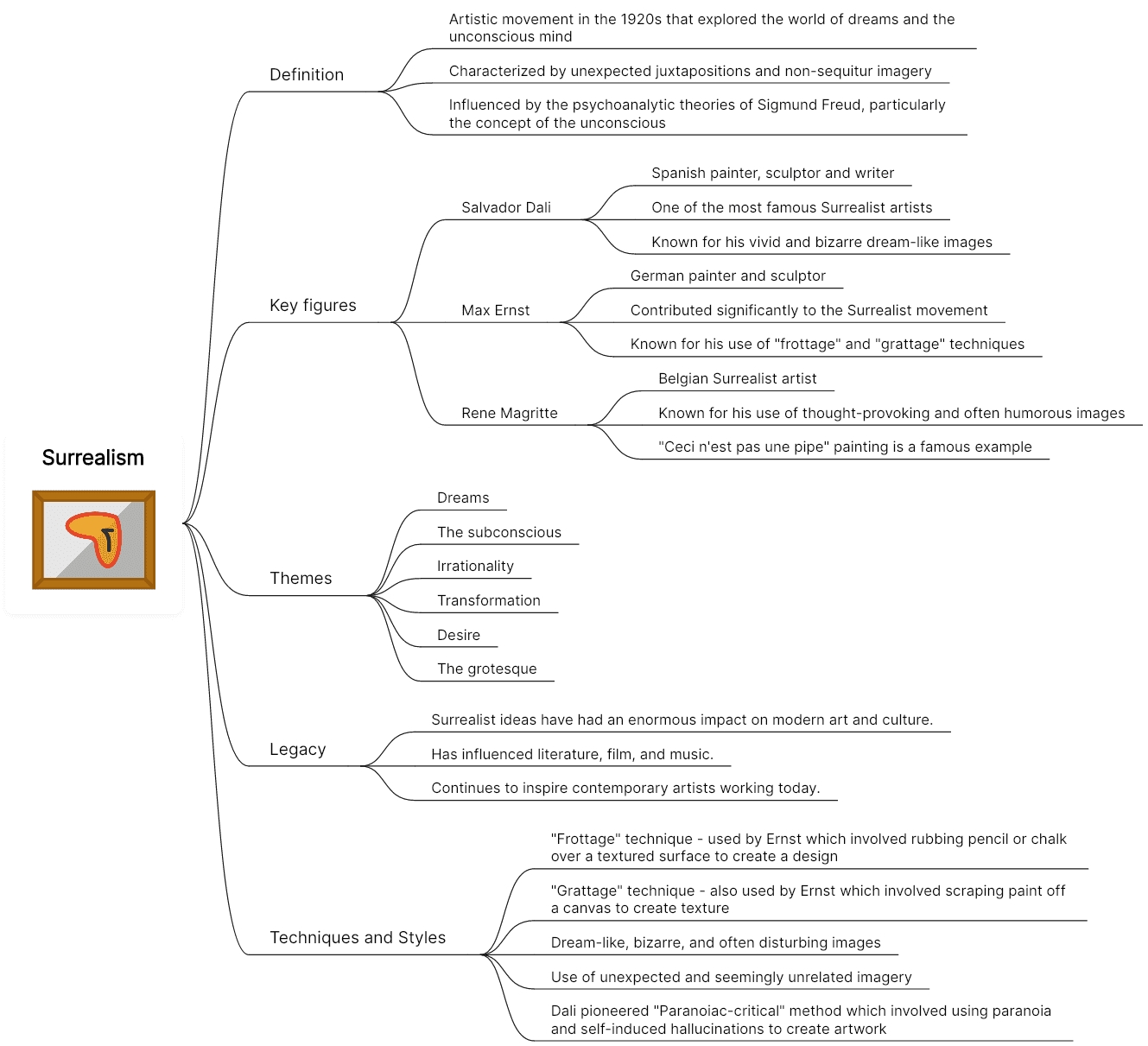
Mind map of Decorative Arts
Unlike fine arts, whose emphasis is mainly on aesthetics, decorative arts focus on functional purposes while also showcasing artistic design and craftsmanship. The decorative arts have a long history, combining a wide range of mediums like ceramics, glass, metalwork, textiles, furniture, jewelry, and so on. Movements like Renaissance had a great impact on the formation of it, for the prevailing artistic and architectural styles of it were strongly related to the intricate detail and craftsmanship of the decorative arts at that time. The mind map below should give you a deeper look into the decorative arts.
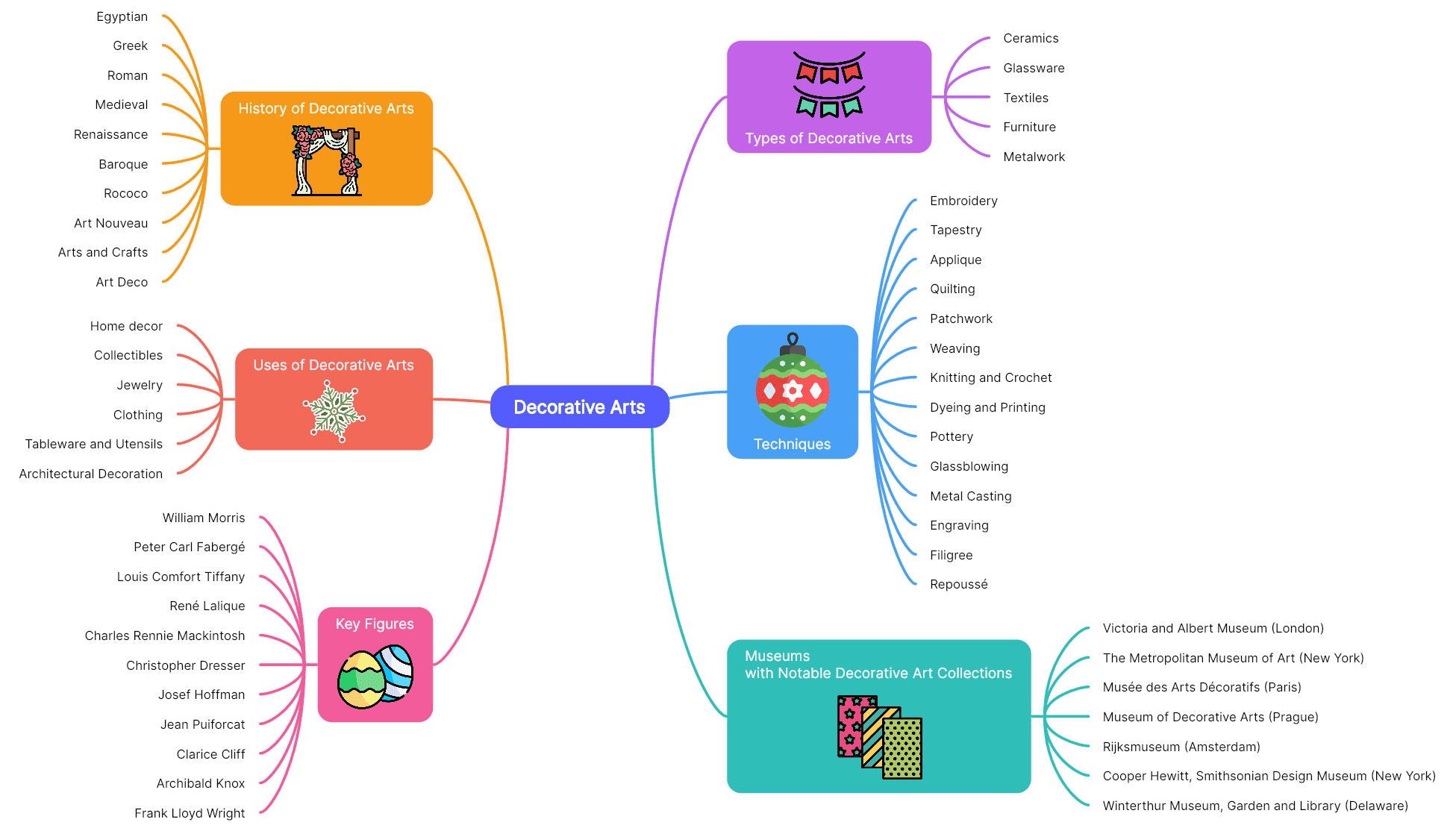
Mind map of Pop Art
Emerging in the mid-1950s, pop art is an artistic movement primarily in the United States and the United Kingdom. Pop artists integrated inspiration from popular culture, mass media, and consumerism into their works of art, which went against the traditional norms. By elevating mundane objects and icons to the level of art through their works, they tried to blur the boundaries between different kinds of art and rejected elitism to embrace a more democratic approach. The following mind map should give you a deeper understanding of pop art.
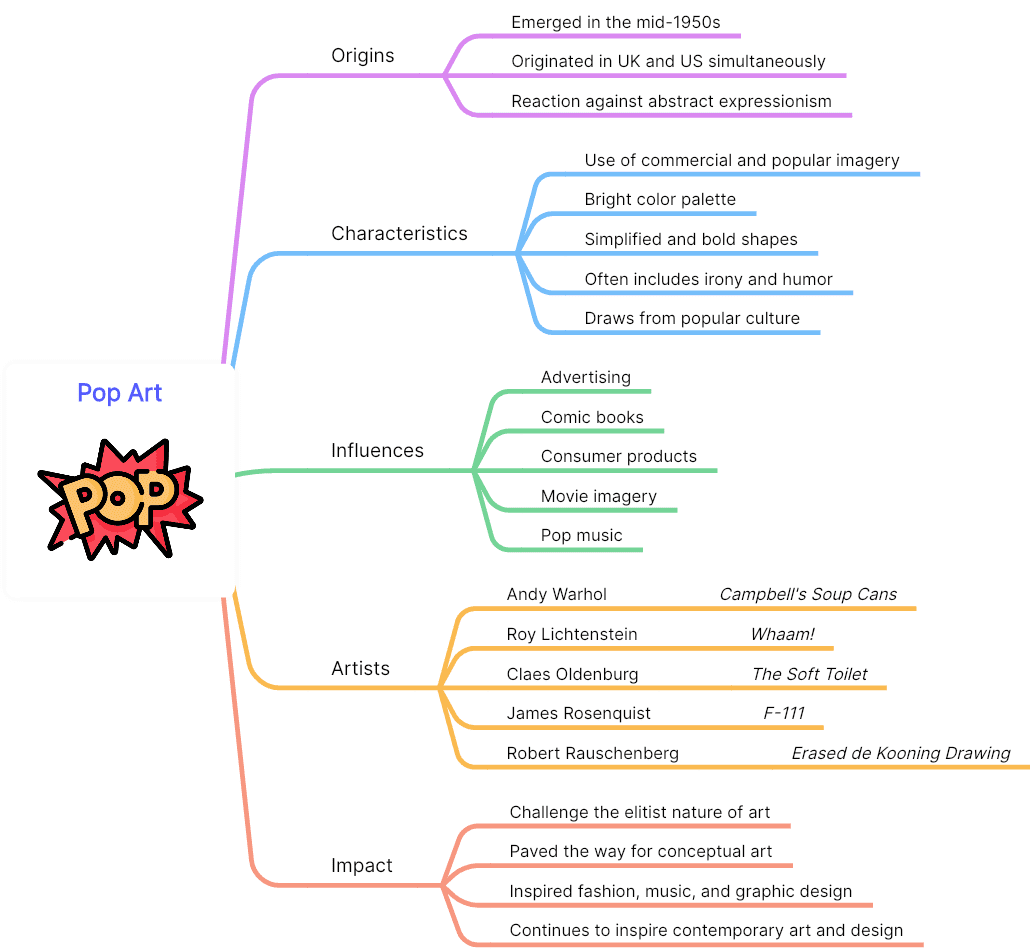
Mind map of Iconography
Iconography refers to the study and interpretation of visual images of symbols, particularly within the context of art, religion, and cultural symbolism. It involves analyzing and understanding the meanings, cultural significance, and historical context of various visual representations. In religious and spiritual contexts, iconography plays a crucial role in depicting deities, saints, and religious events. For example, Christian art often features specific symbols such as the cross, dove, and lamb to represent concepts like salvation or the Holy Spirit. Understanding the symbolism behind these icons deepens our understanding of religious narratives and beliefs. The mind map below should help you know more about iconography.
![]()
Mind map of Semiotics
Semiotics is the study of signs and symbols in human communication. It explores how signs convey meaning and how individuals interpret them in specific cultural contexts. It analyzes the relationship between a signifier (the physical form of a sign) and the signified (the meaning associated with the sign). Semiotics also considers cultural and social factors that influence the meaning of signs. It has applications in linguistics, literature, advertising, media studies, and anthropology. Read the mind map below to learn more about semiotics.

Mind map of Pre-Raphaelite
Pre-Raphaelite art was a movement that originated in the mid-19th century in England. It sought to return to the detailed and vibrant styles of art before the High Renaissance, rejecting the dominant academic and industrialized art of its time. The Pre-Raphaelite Brotherhood, a group of young British artists, prioritized meticulousness in their work, emphasizing intricate detail, intense colors, and a focus on nature and medieval themes. They sought to evoke emotion and tell stories through their paintings. The movement had a significant impact on the art world, inspiring subsequent generations of artists and influencing Victorian aesthetics. The mind map of the Pre-Raphaelite below should give you a clear understanding of it.
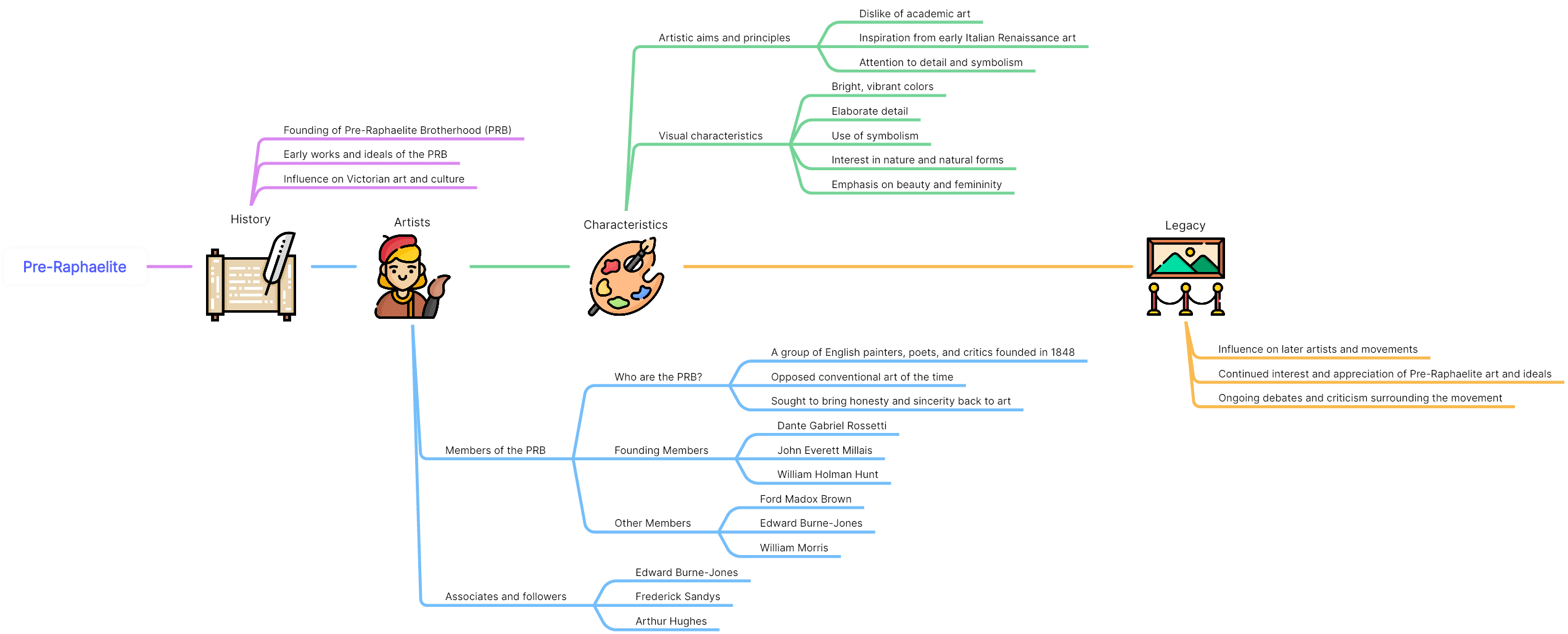
Mind map of Art Nouveau
Art Nouveau, meaning "new art" in French, was an influential art movement that flourished from the late 19th century to the early 20th century. It emerged as a response to the industrial revolution and sought to establish a new aesthetic that blended art and everyday life. The movement emphasized the integration of art into all aspects of life and aimed at creating a harmonious and unified visual experience. Its influence can still be seen today in various design disciplines, captivating people with its distinctive, flowing aesthetic. The following mind map demonstrates detailed information on Art Nouveau.
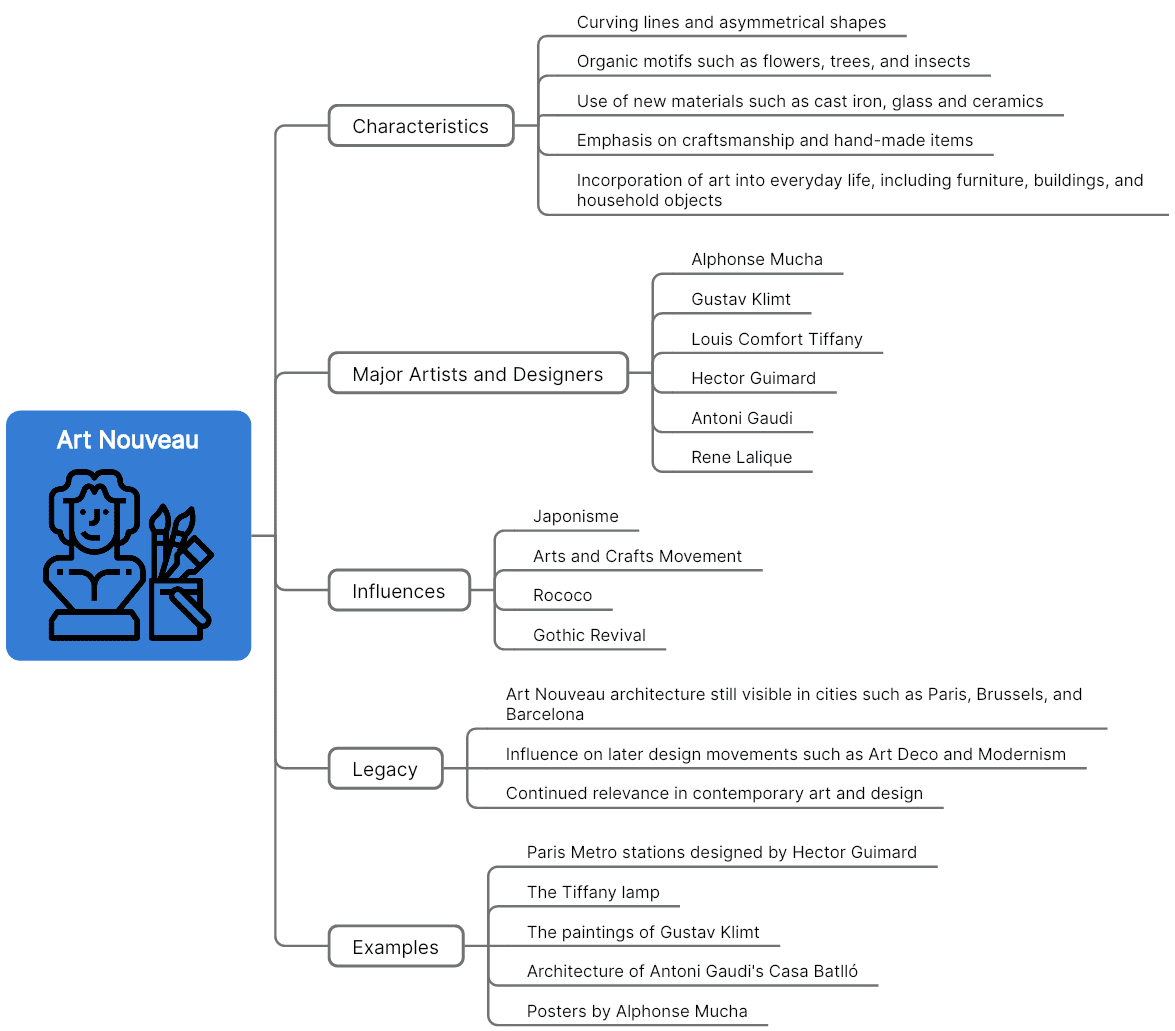
Mind map of Rembrandt
Rembrandt Harmenszoon van Rijn, commonly known as Rembrandt, was a Dutch painter and etcher who is widely regarded as one of the greatest artists. He is famous for his exceptional ability to capture human emotion and create dramatic lighting effects in his paintings. He delved into various genres, including portraiture, landscape, history painting, and biblical scenes. Read the mind map below to learn how his intelligence set him apart from his contemporaries.

Mind map of Salvador Dali
Born in Spain in 1904, Salvador Dali is one of the most renowned and influential artists of the 20th century. He became synonymous with surrealism, and his works expanded the boundaries of traditional art, opening up new realms of imagination. His paintings featured distorted figures, melting objects, and dreamlike landscapes, pushing the boundaries of reality and rationality. The mind map below displays his life and works for you.

FAQs about the art mind map
What is an art mind map used for?
An art mind map is a visual tool used to organize and explore ideas, concepts, and connections related to art. It is commonly used for brainstorming, concept development, research organization, art analysis, critique, and as a teaching and learning tool in the field of art.
What are the benefits of using an art mind map?
Using an art mind map offers several benefits, including:
- Enhanced creativity;
- Organization and clarity;
- Idea generation;
- Visual learning;
- Comprehensive planning;
- Effective communication;
- Art analysis and critique;
- Teaching and learning tools, etc.









